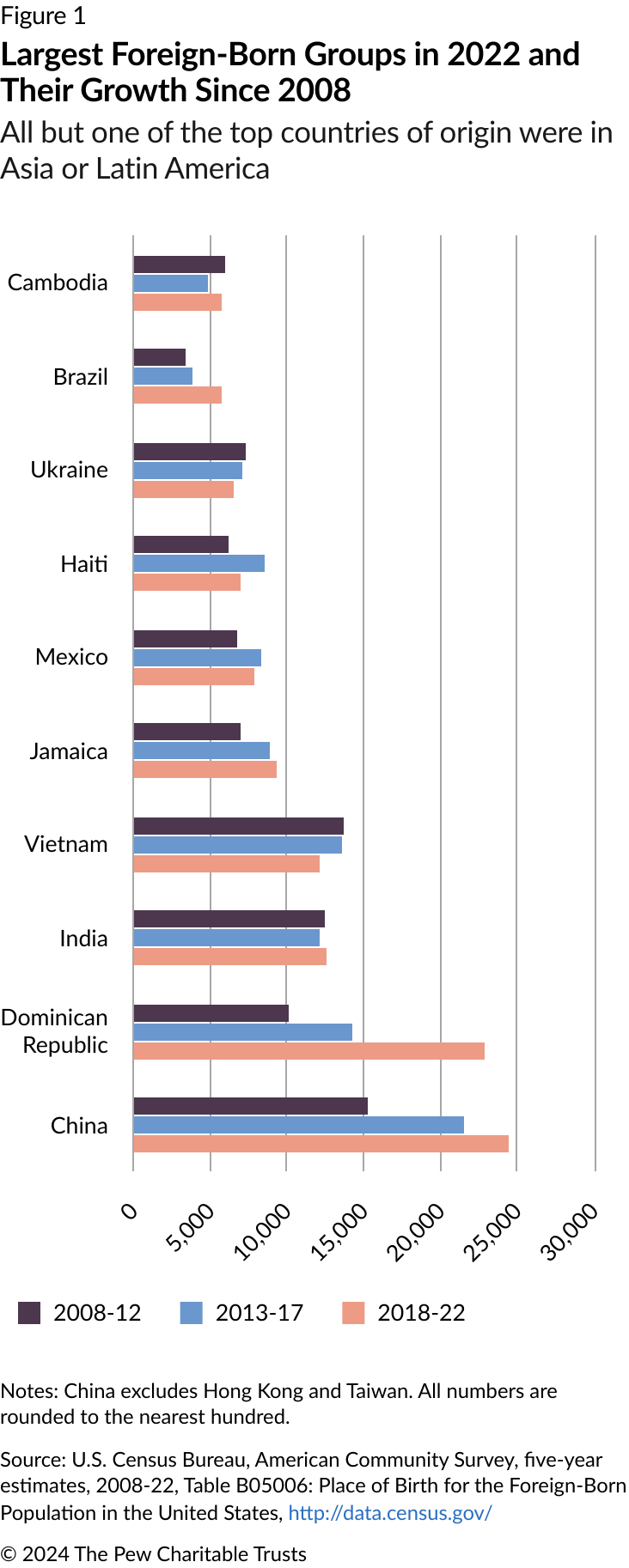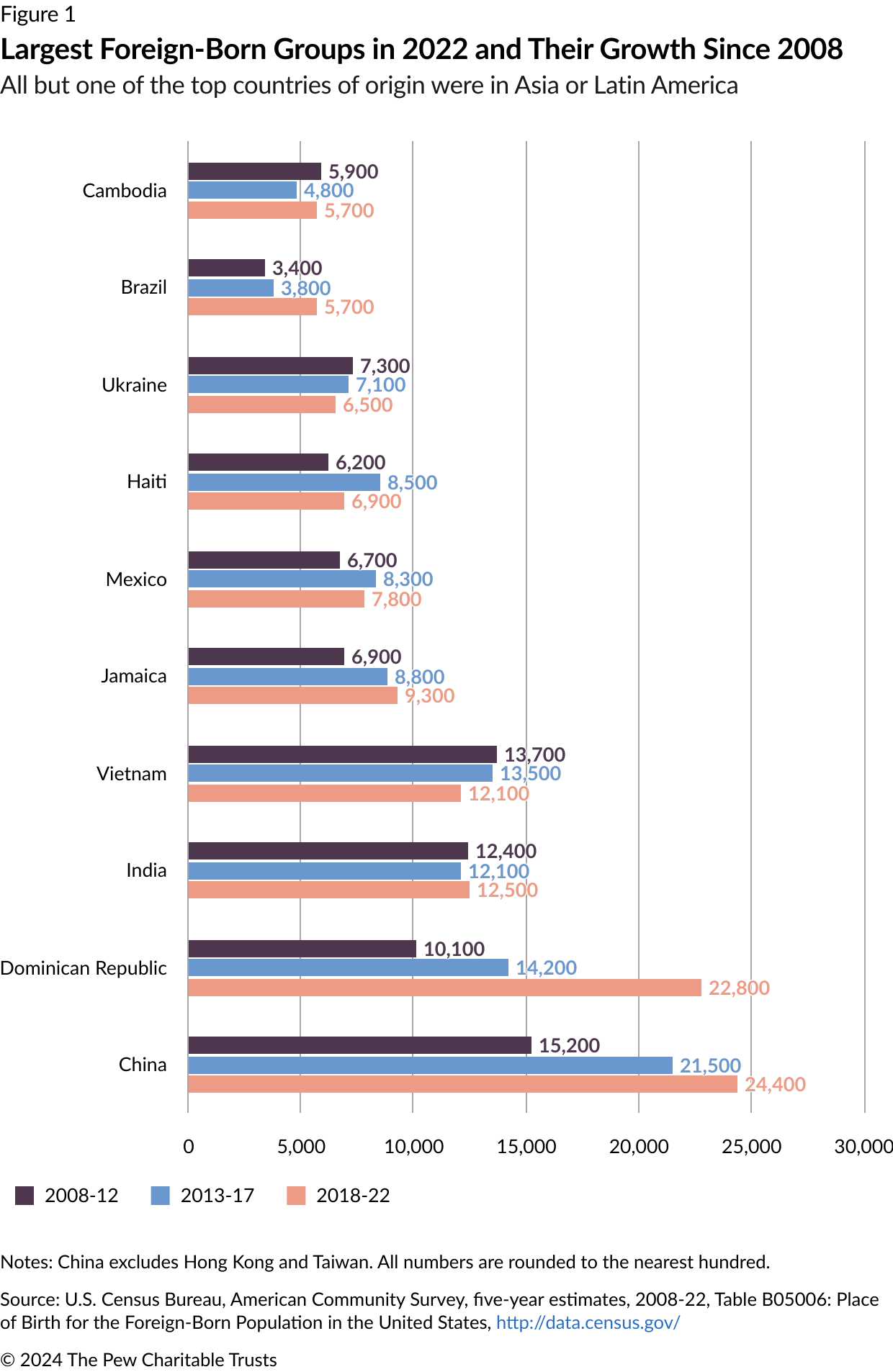Philadelphia's Immigrants: Origins and Destinations
Building communities and finding support in shared backgrounds

Editor’s note: This webpage was updated on June 25, 2024, to restore the missing first line in the paragraph preceding Figure 4.
Overview
The share of Philadelphians born overseas is now the highest it’s been in eight decades, at 15.7%.1 The majority have roots in East Asia and Latin America. In Philadelphia, as in many other cities, immigrants often gravitate toward communities where they can find affordable housing; commerce; other people with a familiar language, food, and culture; and support in navigating their new hometown. These communities include long-standing immigrant neighborhoods like Chinatown, the South 9th Street Italian Market, and the Northeast, and newer areas, such as Southwest Philadelphia, that often serve as gateways in their own right for waves of newcomers.
Top countries of origin
For the last two decades, people born in China (not including Hong Kong and Taiwan) were among the largest foreign-born groups living in Philadelphia, totaling 24,400 in the 2018-22 period—representing almost 1 in 10 of the city’s immigrants. More recently, an influx of residents born in the Dominican Republic has put Dominicans on track to become Philadelphia’s largest immigrant group. Since 2000, only a few groups have decreased significantly in size, while the number of immigrants from Ukraine, Vietnam, and elsewhere has fluctuated. (See Figure 1.)

Many communities, a few enclaves
Immigrants from Asia—a very wide swath of the planet stretching from Turkey to Japan—are extremely diverse in culture and economic status and live in various neighborhoods throughout the city.2
For instance, 1 in 5 Cambodian immigrants reside in Philadelphia’s Olney section. Settled by people fleeing wars in Southeast Asia in the late 1970s, the community now has its own associations and places of worship, a contingent of business and property owners, and a regional attraction in South Philadelphia’s FDR Park called the Southeast Asian Market. And over the years, the area’s residents have coalesced to support one another.
“A lot of our community comes from war; we come from trauma and death. It’s very morbid,” said Sarun Chan, executive director of the Cambodian Association of Greater Philadelphia and himself once a refugee. “Our project provides avenues for people talking and sharing and supporting each other.”
Philadelphians who were born in Vietnam are concentrated in Juniata and Lawndale, while Filipino immigrants are spread more evenly throughout the city. Chinatown, in Center City, is Philadelphia’s most visible immigrant community and could be called an enclave. But its residents are not exclusively Chinese; the largest population of Chinese immigrants actually resides in the Lower Northeast. The Far Northeast, on the other hand, is home to many of the city’s immigrants born in Bangladesh, India, and Pakistan.3 (See Figure 2.)
Caribbean immigrants represent more than half (56%) of Philadelphia immigrants from the region encompassing South America, Central America, and the Caribbean. Most are from the Dominican Republic, Jamaica, and Haiti, and they live predominantly in Northeast and Southwest Philadelphia. South Americans, mostly from Brazil and Colombia, are largely concentrated in the Far Northeast and parts of Center City. Immigrants from Mexico and Guatemala are the largest groups among people counted as Central American by the U.S. Census Bureau and are settled largely in South Philadelphia and parts of the Northeast. (See Figure 3.)
Although Africans are the second-smallest continental group of immigrants in Philadelphia, after people from Oceania, some subgroups are especially concentrated and entrepreneurial. Liberians, Nigerians, and other West African immigrants have a sizable business and community presence in Southwest Philadelphia, where several groups are building an “Africatown” complex. African immigrants from Egypt and Morocco are most concentrated in Northeast Philadelphia. And many immigrants from Cameroon and elsewhere in Central Africa live in West Philadelphia. (See Figure 4.)
Through the first half of the 20th century, Western Europeans born in Ireland, Italy, Germany, and elsewhere were the largest immigrant groups by continent of origin in Philadelphia. Today, Eastern Europeans—namely Albanians, Ukrainians, and others from post-Soviet countries—are dominant, with their largest concentrations in Rhawnhurst and Bells Corner in the Northeast. (See Figure 5.)
An ability to speak English—one of the most important skills for new immigrants to have or learn in the United States—varies widely by national origin, often because of language differences in people’s country of origin and their access to education before and after migration. The city of Philadelphia in recent years has provided an annual average of 106,400 interpretations or translations along with its public services (not including school language programs).4 The largest immigrant groups—Philadelphians born in China and the Dominican Republic— also have the highest number of people who report struggling with English. However, among immigrant groups with at least 800 people living in Philadelphia in the 2018-22 period, those with the highest share of residents unable to speak any English were from Brazil, Colombia, the Dominican Republic, and Guatemala. (See Table 1.)
Table 1
English Ability by Birthplace and Native Language, 2018-22
Immigrant groups with at least 800 people ages 5 and older, ranked by share who say they do not speak English well
| Country of origin and its main or official language | Percentage of population who say they do not speak English well | Percentage of population who do not speak English at all |
| Uzbekistan (Uzbek/Russian) | 44% | 0% |
| Guatemala (Spanish/Mayan languages) | 42% | 27% |
| Vietnam (Vietnamese) | 39% | 12% |
| Cambodia (Khmer) | 38% | 17% |
| Brazil (Portuguese) | 33% | 26% |
| China (Mandarin) | 31% | 18% |
| Mexico (Spanish) | 29% | 15% |
| Ukraine (Ukrainian/Russian) | 26% | 7% |
| Colombia (Spanish) | 24% | 30% |
| Dominican Republic (Spanish) | 22% | 26% |
| South Korea (Korean) | 21% | 4% |
| Haiti (Creole/French) | 16% | 1% |
| India (Hindi) | 15% | 3% |
|
Sources: U.S. Census Bureau, American Community Survey, five-year estimates, 2018-22, from IPUMS microdata, http://www.ipums.org/; U.S. Central Intelligence Agency, The World Factbook: Field Listing—Languages, https://www.cia.gov/the-worldfactbook/field/languages/ |
Philadelphia’s foreign-born residents come from every corner of the globe, some in bigger numbers than others. They often congregate in pockets where they can find support, affordability, opportunities, and shared languages, although those concentrations also dissipate or shift over time as they integrate into the fabric of Philadelphia.
Endnotes
- The Pew Charitable Trusts, “Philadelphia 2024: The State of the City” (2024), https://www.pewtrusts.org/en/research-and-analysis/reports/2024/04/philadelphia-2024.
- Determining whether an area could be called an “ethnic enclave,” where a particular group owns or runs most of the area’s commercial, cultural, and social businesses and activities, was beyond the scope of this research. Sociologists and anthropologists do not have a standard quantitative definition of an ethnic enclave. See A. Portes and L. Jensen, “Disproving the Enclave Hypothesis,” American Sociological Review 57, no. 3 (1992): 418-20, https://www.jstor.org/stable/2096246.
- The very broad census category “Asian,” as defined by the federal government, has been heavily scrutinized in recent years. Federal officials, academic experts, and advocacy groups are nearing completion on a plan to create a separate geographic category for Middle Eastern and North African countries that’s distinct from the broader Asian category.
- City of Philadelphia Office of Immigrant Affairs, “PHL Language Services Usage,” April 15, 2024, https://experience.arcgis.com/experience/51923768a6b14d5bb773bfcc1cf74cd1/.


Philadelphia's Immigrants
A series on the traits and impact of a growing population


How Immigrants Have Helped Philadelphia Grow















